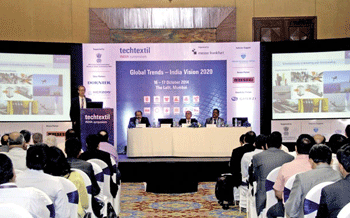
Techtextil India meet stirs more interest in tech textiles
The two-day Techtextil Symposium held recently in Mumbai´s The Lalit Hotel had an impressive line of presentations on the various aspects of technical textiles. Michael Janecke, Director (Brand Management)
The two-day Techtextil Symposium held recently in Mumbai´s The Lalit Hotel had an impressive line of presentations on the various aspects of technical textiles. Michael Janecke, Director (Brand Management), Messe Frankfurt, spoke on how Techtextil 2015 and Techtextil India 2015 would be attracting a huge crowd since the fibre use for technical textiles is shooting up and up. He spoke briefly about the popularity of the German edition of Techtextil and wished that there would be more interested visitors from India since over the years, the number of stake-holders in technical textiles have gone up tremendously in the country.
Hendrik H van Delden, Managing Partner , Gherzi van Delden GmbH, Germany spoke on the ¨Global Market Scenario and Trends¨ in the first session on technical textiles and nonwovens. In his presentation, which focused on composites, he said that India is already a large consumer of fabric based (high performance) composites, e.g. in the wind energy sector and that other markets with potential are transportation, defence and infrastructure but also exports are emerging for Indian producers. He concluded by saying that with falling fibre prices, carbon is outgrowing glass and that NCF is growing faster than wovens (also in glass) but is limited to large lots. Besides, braids show high potential for demanding parts and applications (prop shaft, sports goods…). Besides, re-use of carbon fibre waste (e.g. from RTM preform production) – such as by conversion into non-wovens – is a highly promising topic with first commercial products already being presented in the US.
Speaking next, Pierre Wiertz, General Manager of EDANA, reminded the Indian industry leaders and supply chain representatives for both technical textiles and nonwovens attending the event that the global growth rate of the overall production of nonwovens has outpaced that of many other industries´ output since the beginning of the 21st Century or so (and well before already), but in doing that, it had more often been following rather than outpacing the global economic growth.
¨This makes nonwovens one of the fastest growing fibre-consuming sectors, if not the fastest¨ remarked Wiertz, ¨but nonwovens are not just textiles, as they can be made of many other materials such as cellulose, carbon or mineral fibres than what conventional classifications consider to be ´textile fibres´.¨
Comparing the stage of developments of the various continental bases of nonwovens production and consumption, Wiertz suggested that almost exactly as the earth´s population reached 7 billion people in 2011, the world annual average per capita consumption figure of nonwovens reached an impressive and unprecedented figure of 1kg (as global nonwovens output reached 7 million metric tonnes). Considering the current slow-down in nonwovens growth since then, it will however probably take to 2021 or longer to double this symbolic level. ¨Asia will see the fastest growth rates, but while China has already reached a remarkable level of over 1kg/capita – admittedly still less than half of the European level, India is lagging behind, with less than 0.3kg, or 300g per capita¨, continued Wiertz.
The panel of speakers presenting nonwovens developments in India agreed that the growth of the Indian nonwovens industry´s output was poised to accelerate from the current level around 250,000 tons, but also, to shift in quality and end-uses.
¨EDANA, concluded Wiertz, ¨is determined to support the development of the nonwovens industry in India by any suitable means¨. As a result, he announced a major EDANA nonwovens conference in the first quarter of 2016, to cover market developments in all priority segments.¨
With the Indian government keen to increase the contribution of manufacturing in the economy, local technical textiles sector is expected to grow at 20 per cent CARG over the next decade. Speaking about how the sector can achieve this gr




